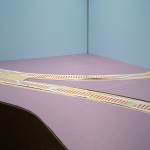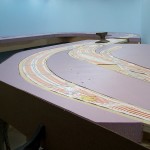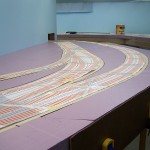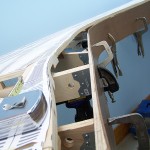The base 2″ of foam is installed across all of the layout that receives foam landscape, the Ohio and Michigan areas. While it doesn’t presently look like terra firma it will eventually. More foam will be added for hills and higher elevations. Foam will be carved out for gullies, ditches, and lower elevations. And a layer of sculpted plaster will cover it all. By the time it’s done there won’t be very much flat area left.
The real reason for foam installation at this time is twofold. As stated in a previous post, it was easy to trace the cut line from below because with no track in place the foam lays flat on the layout. The other reason, and likely the more important, the foam will keep trains from taking the plunge to the floor if there is a problem during track laying. Back in my slot car days a friend of mine, Tim, coined the term “concrete poisoning” when the cars flew off the track onto the floor 4′ below. Acute concrete poisoning was a result of “sudden deceleration syndrome”. Having foam in place during track testing will guarantee none of my trains suffer such ailments. Think of it as foam preventative medicine. 🙂
The cookie cutter construction method is inherently wasteful. A bunch of oddball shaped scrap is generated. To minimize my waste foam, and dollars spent buying more sheets, I glued together scrap pieces to make Frankenstein larger pieces from which I could make landscape panels. You will see a few pics in the gallery below of the glue and clamp process. Loctite PL300 was used to glue the pieces since it is designed for foam bonding. I can now attest it works very well. Not the speediest adhesive I have ever used. It requires 24 hour clamping.

In gap filling areas where the adhesive is thick it takes several days to harden. But once it is cured it does bond foam to foam very well. I’ll eventually use the same adhesive to affix the panels to the layout permanently. For now they are only laying in place.
Here’s something I learned along the way. Foam insulation panels are not manufactured to a precise uniform thickness from sheet to sheet or even with the same sheet. I discovered this when I butted together two pieces and there was 1/8″ difference in height. Hmm, why? It really doesn’t matter since it will all be carved up and plastered over but it made me curious. Inquiring minds need to know! I started paying close attention to the joints and where they were cut from the sheet. Turns out there is variation between sheets and between areas of the same sheet. I suppose when the foam is used in its intended application as house insulation it doesn’t matter. Fortunately, it doesn’t matter on my railroad either. But if you are planning on using foam insulation sheets in something that is dimensional critical then beware.
What more can you say about foam? It’s foam. Here are more pictures than anyone could ever want of the foam installation on the LK&O. Until next time…








































Great work Alan. I stumbled upon your blog some 18 months ago, read a few entries then moved on. I revisited it this past weekend (cold and snowy…it was great reading!)and read it in it’s entirety. I am in awe of your patience to make it just so on everything. Commendable. I am in the beginning phases of basement prep for my “life layout” and I can honestly say that your blog has allayed some of my fears, though the myriad of wiring for your lighting scares me to no end! Not a strong suit for me. Sawdust is my forte! I wish you continued success with your layout.
Jeff
Plymouth, IN